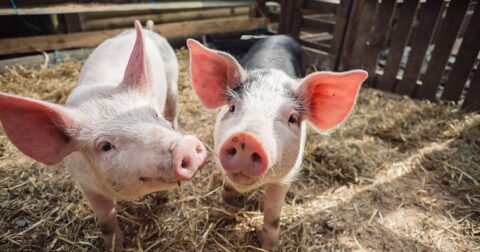News
Tech to End Chick Culling Has Now Been Implemented, but Challenges Remain
Breakthroughs•3 min read
Reported
A new study shows pigs socialize in similar ways to humans.


Words by Tove Danovich
As anyone who has ever been on a team or a tight friend group knows, an unresolved conflict can tear a group apart. Sometimes it can be easier for a third party to step in to keep the peace and calm everyone down. Humans do this but studies have also shown the behavior in wolves, primates and birds.
A new study published in Animal Cognition this month finds that pigs too adopt a strategy of “triadic contact” to resolve conflicts within their groups. First study author, Giada Cordoni at the University of Turin wrote in an email that they were surprised to see a “consolatory effect” in the pigs they studied.
When a third-party pig approached an aggressor-pig, for example, the aggressor was less likely to attack again. Contact with the victim also seemed to reduce that pig’s anxiety, and even potentially offer them protection in future interactions.
To research conflict management in pigs, the authors spent six months watching a group of 104 pigs on a farm that allows animals to live in semi-natural conditions. Every time the researchers noted aggressive behavior — which in pigs could look like pushing, biting or lifting the victim — they spent the next three minutes observing the pigs to see how they resolved their conflicts. In some cases, conflicts resolved on their own, but in others, bystander pigs intervened, especially in situations involving a pig they were closely related to.
Little was previously known about the effects of third-party intervention in pig social groups. “Insight into this behavior from different scenarios — such as free-range [pigs] — is valuable,” wrote Irene Camerlink, a researcher at the Polish Academy of Sciences, by email. She was not involved in the study but often studies pigs. The findings of this study could lead to improvements in regrouping strategies — keeping siblings together to help farmed pigs maintain stable social groups even when moved to a new location, for example.
Most farmed pigs reared in industrial agriculture are grouped together in confinement in ways that look nothing like the ways in which their wild counterparts socialize. That could lead to conflict. “When the social group is unstable, there will be more agonistic behavior which can result in unrest and stress and even reduce growth,” Camerlink said.
Wild pigs tend to hang out in groups of 2-4 adults with a smattering of young pigs ranging in age, notes a report on the pig industry by the Humane Society of the United States.
Factory farm holding pens, on the other hand, sometimes contain up to 30 animals, with entire barns filled with so many of these pens that there can be hundreds of animals in each.
Young pigs are also often moved from farrowing farms in one part of the country to growing operations in another. Handling and transport can be stressful for any farmed animal but pigs’ preferences for smaller groups might add yet another layer of stress, potentially triggering conflict. Another potential stressor is the regrouping — rearranging groups of pigs in confinement — which happens frequently in commercial pig rearing.
Campaigns to improve animal welfare often focus on the worst offenses in industrial animal agriculture. Controversial gestation or farrowing crates for pregnant pigs — banned in California by a ballot measure and now under review by the Supreme Court — are just one example. Overcrowded conditions and bad air quality inside of barns are another.
Yet, as Sébastien Goumon, who studies animal behavior at ETH Zurich, noted in an email, “Welfare does not only mean reducing experiences associated with negative emotion states but also promoting experiences associated with positive emotional states.”
“Pigs can recognize conspecifics” — animals of the same species — said Goumon. “To some extent,” he added, they “can identify and are affected by the emotional state of others.” Just how much remains a question. Still, says Goumon — this study, which he was not involved with, explores the extent of their empathetic abilities.
The pigs in the study seemed to show quite a bit of emotional intuition. Bystander pigs weren’t just aware that a conflict had taken place but even knew when it was appropriate to intervene with the aggressor or the victim. This and the fact that their approach depended on their genetic relationship to the pigs points toward these animals having complex cognitive abilities, socio-emotional regulation and social appraisal, the authors note in the study. This is just one study on one group of pigs but further research into the social dynamics of these animals could be even more revealing.